Understanding Overkill Sterilization: An End to the Confusion
The author clarifies the definition and objectives of overkill sterilization for steam sterilization cycles. Current sterilization practices are reviewed and the validation difficulties associated with the various definitions of overkill sterilization are explored.
The overkill method is perhaps the most common method used in the development and validation of sterilization processes. Overkill sterilization primarily is applied to the moist-heat processing of materials, supplies, and other heat-stable goods. It generally is considered to be the simplest and most straightforward method for the design and validation of moist-heat sterilization processes. Although this is true, there is substantial confusion about how to use the overkill method and, in fact, regarding what actually constitutes an overkill process. Confusion associated with the overkill approach exists in all of the widely used sterilization technologies; that is, moist heat, dry heat, gas, and radiation. This article focuses on steam sterilization, of which there is both a greater amount of published definitions and a more precise and generally accepted understanding of the underlying science.
A contemporary definition of overkill moist-heat sterilization follows: "This is usually achieved by providing a minimum 12-log reduction of microorganisms having a D-value of at least one minute at 121 °C" (1). This is a simple-enough definition. Unfortunately, it cannot be demonstrated in a straightforward manner with presently available technology. What this definition suggests is that overkill requires a 12-D process, which equates to lethality sufficient to deliver a 12 × D121 lethality level. This is not a lethality standard at all, however, because it inappropriately links the process lethality requirement to the characteristics of a specific biological indicator (BI). This article reviews present sterilization practices and explores the difficulties inherent in this definition.
Sterilization basics
Sterilization as a process can be rather simply defined as:
a validated process used to render a product free of viable organisms. In a sterilization process, the nature of microbiological death or reduction is described by an exponential function. Therefore, the number of microorganisms which survive a sterilization process can be expressed in terms of probability. While the probability may be reduced to a very low number, it can never be reduced to zero (2).
The difficulty lies in demonstrating the effectiveness of that process. The death of microorganisms by any sterilization method has been shown to generally follow a straight line termed the "death curve" (see Figure 1).
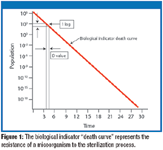
Figure 1
This phenomenon occurs with all microorganisms and is not restricted to any particular species. The slope of this line represents the resistance of the microorganism to the sterilization process. The death curve for organisms exhibiting substantial resistance will have a shallow slope, and those with low resistance to the sterilization process will have a much steeper slope (see Figure 2).
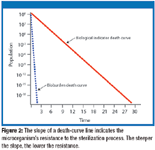
Figure 2
The difference in microbial resistance is critical to sterilization validation. The microbial genera Geobacilli, Bacilli, and Clostridia, having substantial resistance to the sterilization process, are commonly chosen as BIs to provide an appropriate evaluation of the process. These BI organisms are stipulated to be spore populations that have much higher resistance to sterilization processes than the vegetative cells that predominate in the normal microflora found in pharmaceutical production environments. Using these spores as indicator organisms creates a process challenge that is inherently worst-case. In the case of moist heat in which sterilization conditions are very well defined and understood, BIs are best used to establish that there is sufficient correlation between physically measured lethality, generally in the form of thermometric data, and biological lethality measured using calibrated BIs.
Sterilization processes are designed using one of three basic approaches (including the overkill method), each of which requires some degree of knowledge of the resistance and population of the bioindicator and bioburden (1). The bioburden method requires detailed knowledge and control over the bioburden resistance and population. The bioburden/biological indicator (BB/BI) method relies on the difference in resistance of the bioburden and BI (see Figure 2). With information about and control over the bioburden population and resistance, sterilization cycles requiring less time and temperature (relative to the overkill method) can be used successfully. Both of these methods allow for lower heat input to the materials being processed (an important consideration for terminal sterilization of filled product containers or the sterilization of in-process fluids and laboratory media), provided that increased attention is paid to presterilization bioburden.
The overkill method relies upon the selection of a lethality level known to be adequate to ensure sterilization without routine control over bioburden. A delivered F0 of 12 min is an example of an overkill level of lethality. The basis for this level is that if the bioburden on an article were one million and all of that bioburden consisted of resistant spores with a D121 value of 1 min, then a 10–6 probability of a nonsterile unit (PNSU) would be consistently attained. Obviously, this reflects worst-case assumptions regarding both the bioburden level and resistance, which would in every instance be lower in the real-world condition. The role of the BI would be to prove that there is a strong correlation between a physically determined F0 of 12 min and biological lethality at the location of the indicator. A good correlation between biological and physical lethality ensures that an efficient and well-designed cycle with suitable steam penetration and air removal (where necessary) exists.
If understanding of overkill sterilization were all that is needed, this effort would be complete. The difficulty lies in validating overkill sterilization in a manner that is easily defendable to those unfamiliar with sterilization science and realistic in its execution. The first and simplest step is to define the minimum process objective for the sterilization process. The objective is the universal maximum probability of a single nonsterile unit (PNSU) in 106 units (a PNSU of 1 × 10–6 for any individual item). This is nothing more than an acceptable risk of contamination, whose origin (in the food industry) goes back many years. This criterion is the same for all sterilization processes, regardless of the sterilization method or the cycle approach used. The expectation is that the routine process will achieve the desired PNSU and that the routine process requirement does not apply to the validation effort. If that were not the case, then there would be no difference in the cycle approaches. The intent is always to establish the process such that it provides the same minimum confidence in the sterilized materials regardless of the varying controls defined.
Definitions of overkill cycles
The difficulties with overkill sterilization begin at this point. What is an overkill process? Including the currently prevalent definition of overkill given previously, there are various definitions, each of which satisfies the base requirement of a maximum PNSU of 1 in 10–6 but with varying process requirements. These definitions are presented in Table I, including assessments of the validation difficulties associated with each. It should be immediately evident, that the definitions are nonidentical, and thus the process required to achieve overkill is not constant for the various methods. The differences and difficulties associated with the varying definitions is a problem of some magnitude and is the main reason this article was developed.

Table I: Definitions of overkill sterilization and assessments of the validation difficulties for each.
What should be immediately evident is that the various definitions of overkill, and thus the validation of overkill sterilization for moist-heat processes, lack consistency. Simply put, demonstration of overkill is variable depending upon the regulatory or compendial expectations. Perhaps most unfortunate of all, none of the definitions include a requirement for nor provide a means to directly support a PNSU of 1 in 10–6, which is something every sterilization process is expected to achieve.
The half-cycle method
To support the minimum PNSU, some practitioners adopt the half-cycle approach in which a 106 population of a resistant indicator is inactivated during the validation effort, and then the exposure period is doubled in routine operation. It relies on simple mathematics. Killing a BI with an initial population of 106 in the half-cycle validation study means at least a 9-log reduction has been attained. (A routine sterilization cycle with double the exposure period projects to >18-log reduction). This assumes the bioburden is identical in count and resistance to the BI, which is virtually impossible in the real world. The PNSU for a typical bioburden microorganism using this approach could easily exceed 10–200 or greater (see Table II for an example of half-cycle using an 8-min validation cycle and 16-min routine cycle with an initial microbial population of 106).
Figure 3 represents this process and the effect on the BI microorganism. (The D121 value of the BI in Figures 3–6 is approximately 1 min.) The slope of the death curve, which depicts the number of surviving microorganisms at a time point, is known precisely only during the survivor-curve region where the number of survivors can be readily determined. The numbers of potentially surviving BI organisms in the fraction-negative region can be estimated using various methods requiring multiple challenge units exposed at cycles where some but not all of the BIs are rendered sterile. Extension of the death curve below a survival probability of 1 × 10–2 to 1 × 10–3 assumes that the death curve is logarithmically linear. This is a reasonable assumption because microbial death follows essentially first-order kinetics.
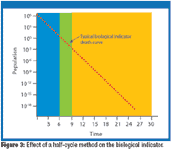
Figure 3
The confirmation of a 1 × 10–6 PNSU using any microbial challenge available can only be assumed, but it can be assumed with a high degree of confidence based upon biological lethality data. This salient point must be accepted without question. Irving Pflug has explained, "Accept that while the objective of a sterilization process may be a PNSU of 10–6, we cannot directly measure microbial levels of less than one surviving microorganism in 10 to 100 units (from 10–1 to 10–2). Therefore when designing or validating sterilization processes, we use indirect methods, so we have real measurements that are equivalent to our nonmeasurable PNSU of 10–6" (9).
In a sterilization validation study using an initial BI population of 106 spores per indicator, 20 strips per study, and three replicate runs in which no survivors are observed, the log reduction demonstrated requires approximately 9 logs (106 × 20 × 3 = 6 × 107 reduced to zero survivors) (see Figure 4).
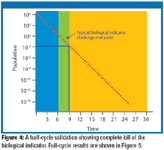
Figure 4
If this process is considered the half cycle, then the full cycle (with twice the exposure time) is depicted in Figure 5.
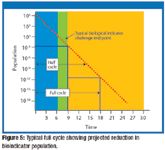
Figure 5
Because the lethality of the full cycle cannot be demonstrated using a biochallenge and recalling that a 106 BI challenge is destroyed in the half cycle, the log reduction delivered to the BI must be assumed. Using the assumed log reduction for the half cycle and doubling the dwell time, the log reduction for the BI in the full cycle can be estimated at 18 logs and easily meets the overkill definition of a minimum 12-log reduction of a BI with a D-value of 1 min (assuming the BI had a D121 > 1 min) as is typical in nearly all overkill validation studies.
There are several inherent assumptions with the half-cycle method. The first assumption is that the bioburden would be as numerous and resistant as the BI. Second, it is assumed that the complete destruction of the multiple BIs in triplicate studies demonstrated a 9-log reduction of that BI. Finally, the death curve of the BI is assumed to be linear in a region where it cannot be experimentally determined.
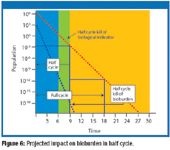
Figure 6
Sterilization process objective
The routine sterilization of items in any sterilization process is intended to destroy the bioburden microorganisms that might be present on or in the materials being processed, regardless of their initial population and resistance. The goal is constant: to attain a minimum PNSU of 10–6. Consider the following definition of overkill sterilization as being consistent with what process expectations should be:
Overkill sterilization is a process where the destruction of a high concentration of a resistant microorganism supports the elimination of bioburden that might be present in routine processing. That objective can be demonstrated by attaining any of the following: a defined minimum F0, a defined time-temperature condition, or a defined log reduction of a biological indicator.
This definition reflects the process requirement directly, with full recognition that bioburden organisms typically have minimal heat resistance. Destruction of the BI in high concentration requires time and temperature conditions far in excess of what is required to destroy the bioburden, and thus overkill is demonstrated.
Demonstrating a minimum PNSU of 1 × 10–6 for a sterilization process can be ensured only where the number and resistance of the microorganisms present on or in the items being sterilized is known. This can be accomplished definitively using any of the sterilization-cycle approaches described previously, and delivering that lethality is not restricted to the overkill method. It is supported by information about the relative resistance of the bioburden to the biological indicator in the BB/BI method in which partial kill of the indicator is sufficient to support the required minimum PNSU for the bioburden. With the overkill method, complete destruction of the resistant BI in high numbers is more than sufficient to ensure the minimum PNSU for any conceivable bioburden.
In everyday usage of sterilizing equipment, the BI is not present. The process is expected to confidently destroy the bioburden. In today's industry, we have numerous controls on the pre-sterilization bioburden, and in many instances, especially terminal sterilization, it is monitored for each sterilizer load.
If we were to make a worst-case bioburden assumption, it might be a maximum of 1000 CFU of a resistant sporeformer such as Bacillus subtilis or Bacillus atrophaeus. These mesophilic sporeformers are occasionally found in pharmaceutical plants during environmental monitoring and bioburden sampling. The maximum reported D121 for these species is <0.5 min. It should be immediately evident from Table II that the 8-min validation (the half cycle) cycle achieves the maximum PNSU that exceeds the 1 in 10–6 expectation for any microorganism with D121 ≤1 min. For the assumed bioburden of 0.5 min, the log reduction in the half cycle relative to a BI with D121 = 1 min is greater than 18 logs. The half-cycle process will reproducibly attain the universal expectation of a minimum PNSU on 1 × 10–6. For bioburden organisms that are not sporeformers, the level of safety is even greater (see Table II).
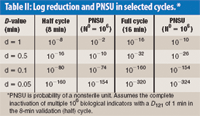
Table II: Log reduction and PNSU in selected cycles.
Overkill sterilization is thus attained for bioburden microorganisms (even those with substantial resistance) in relatively short cycles without the need to double the cycle. The excessive heat input necessary to use a half-cycle approach should not be considered benign. Elastomeric closures, tubing, filters, gasket materials, hoses, and other materials that are commonly sterilized using the overkill method can all suffer adverse effects as a consequence of extended sterilization times. Obviously, the half-cycle approach should never be used for heat-sensitive materials, as it almost always results in unnecessary degradation of the material being processed.
Although the half-cycle method might seem acceptable to some, it strikes this author as an overly conservative approach that belies the customary industry controls on bioburden. There is little, if any, scientific rationale for its continued use in steam sterilization. Requirements for environmental monitoring, cleaning validation, bioburden monitoring, and component preparation all serve to ensure that presterilization bioburden will approach neither the population nor the resistance of the biological indicator. If resistance and count are within reasonable control—that is, being nonthermophilic and meeting the local environmental limits—then any of the alternative approaches can be used.
Conclusion
Process expectations for demonstration of a minimum PNSU of 10–6 are essentially universal. Overkill sterilization in its many variants is only one means of demonstrating that minimum expectation. Its demonstration for routine processing relies on either knowledge or assumptions regarding the bioburden number and resistance and little else. As the challenge microorganism is not present in routine sterilization, only information about the bioburden is relevant to establishment of the desired PNSU.
James Agalloco is president of Agalloco & Associates, PO Box 899, Belle Mead, NJ 08502, tel. 908.874.7558, jagalloco@aol.com He is also a member of Pharmaceutical Technology's Editorial Advisory Board
Keywords: Sterilization
References
1. PDA, Technical Report 1: Moist Heat Sterilization in Autoclaves, draft 12C, 2002.
2. PDA, Technical Report 22: Process Simulation Testing for Aseptically Filled Products, 1996.
3. "‹1211› Sterilization and Sterility Assurance of Compendial Articles," in USP 29 (US Pharmacopeial Convention, Rockville, MD, 2006).
4. Decision Trees for the Selection of Sterilization Methods (CPMP/QWP/155/96), 1999.
5. Validation protocol, circa 1980.
6. Validation protocol, circa 1990.
7. FDA, 21 CFR 600.11 (b)
8. FDA 21 CFR 212, Proposed June 1, 1976, withdrawn 1991.
9. I. Pflug, Microbiology & Engineering of Sterilization Processes, 10th ed. (Environmental Sterilization Services, St. Paul, MN, 1999).
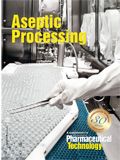
Drug Solutions Podcast: A Closer Look at mRNA in Oncology and Vaccines
April 30th 2024In this episode fo the Drug Solutions Podcast, etherna’s vice-president of Technology and Innovation, Stefaan De Koker, discusses the merits and challenges of using mRNA as the foundation for therapeutics in oncology as well as for vaccines.